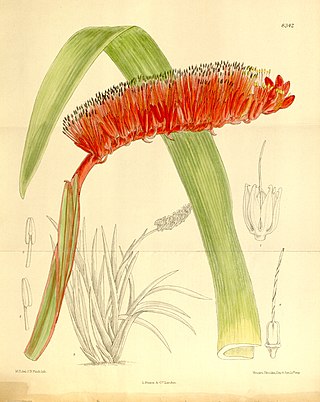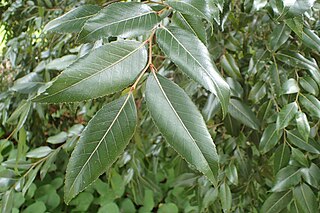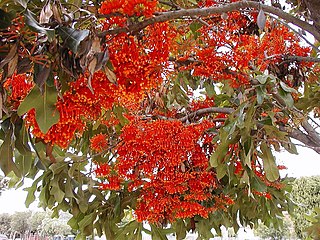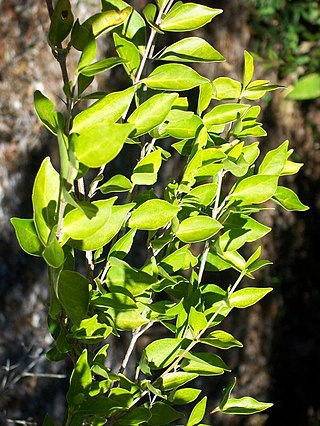
Haast's eagle is an extinct species of eagle that lived in the South Island of New Zealand, commonly accepted to be the pouakai of Māori legend. It was the largest eagle known to have existed, with an estimated weight of 15 kilograms (33 lb), compared to the next-largest and extant 9 kg (20 lb) harpy eagle. Its massive size is explained as an evolutionary response to the size of its prey, the flightless moa, the largest of which could weigh 230 kg (510 lb). Haast's eagle became extinct around 1400, following the arrival of the Māori, who outcompeted it for its moa prey.

Xeronema is a genus of flowering plants containing two species, Xeronema moorei from New Caledonia, and Xeronema callistemon from the Poor Knights Islands and Taranga Island in New Zealand. The plants are herbaceous monocots, spreading by rhizomes, and have large flowers set on terminal spikes, with stamens towering above the flowers.

Crinum is a genus of about 180 species of perennial plants that have large showy flowers on leafless stems, and develop from bulbs. They are found in seasonally moist areas, including marshes, swamps, depressions and along the sides of streams and lakes in tropical and subtropical areas worldwide.

Eucryphia is a small genus of trees and large shrubs native to the south temperate regions of South America and coastal eastern Australia, mainly Tasmania. Sometimes placed in a family of their own, the Eucryphiaceae, more recent classifications place them in the Cunoniaceae. There are seven species, two in South America and five in Australia, and several named hybrids.

Nothofagus cunninghamii, commonly known as myrtle beech or Tasmanian myrtle, is the dominant species of cool temperate rainforests in Tasmania and Southern Victoria. It has low fire resistance and grows best in partial shade conditions.

Nothofagus moorei, commonly known as Antarctic beech, is an important Gondwana relict of the rainforests of the southern hemisphere. It occurs in wet, fire-free areas at high altitude in eastern Australia.

Trimeniaceae is a family of flowering plants recognized by most taxonomists, at least for the past several decades. It is a small family of one genus, Trimenia, with eight known species of woody plants, bearing essential oils. The family is subtropical to tropical and found in Southeast Asia, eastern Australia and on several Pacific Islands.

Macrozamia moorei is a cycad in the family Zamiaceae, native to Queensland (Australia).

Stenocarpus is a genus of about 22 species of flowering plants in the family Proteaceae. They are trees or shrubs with variably-shaped leaves, zygomorphic, bisexual flowers, the floral tube opening on the lower side before separating into four parts, followed by fruit that is usually a narrow oblong or cylindrical follicle.

The motorbike frog is a ground-dwelling tree frog of the subfamily Pelodryadinae found in Southwest Australia. Its common name is derived from the male frog's mating call, which sounds similar to a motorbike changing up through gears; it is also known as Moore's frog, the western bell frog, western green and golden bell frog, and western green tree frog.

Agathis moorei is a species of tree, endemic to New Caledonia. It occurs scattered throughout the main island in subtropical rainforest at altitudes of 250 metres (800 ft) to 1,000 m (3,300 ft). It is threatened by habitat loss.

Trimenia is a genus of plants in the family Trimeniaceae. It contains 13 species.

Eucryphia moorei, commonly known as pinkwood, plumwood, or eastern leatherwood is a tree found in southeastern New South Wales, Australia. It also occurs just over the border at the Howe Range in Victoria. Pinkwood is the dominant tree species of cool-temperate rainforests of southeastern NSW. Young plants often grow as hemiepiphytes.

Citronella moorei is a rainforest tree growing in eastern Australia. Common names for this species include churnwood, citronella, soapy box, silky beech, and corduroy.
Drosera moorei is a scrambling or climbing perennial tuberous species in the carnivorous plant genus Drosera. It is endemic to Western Australia and grows near granite outcrops in sandy loam. D. moorei produces small, circular, peltate carnivorous leaves along glabrous stems that can be 12–35 cm (5–14 in) long. Inflorescences have two to ten yellow flowers and bloom from September to October.

Randia moorei, commonly known as the spiny gardenia, is a rare Australian shrub growing in the far north eastern areas of the state of New South Wales and adjacent areas in Queensland. The habitat is subtropical rainforest north of Lismore.

Eucalyptus moorei, commonly known as narrow-leaved sally, is a species of mallee that is endemic to New South Wales. It has smooth bark, linear to narrow lance-shaped or curved adult leaves, flower buds in groups of between seven and fifteen, white flowers and cup-shaped or shortened spherical fruit.

Legnephora moorei, the round-leaf vine, is a species of plant in the family Menispermaceae. Endemic to the rainforests of Queensland and New South Wales, Australia. Round-leaf vine is a tall and large leafed climber usually noticed by fallen leaves on the rainforest floor. The southernmost limit of natural distribution is at Yatteyattah Nature Reserve on the south coast of New South Wales. The plant is one of the many named after Charles Moore.The stem of the vine can go up to 9 cm.
Stenocarpus moorei is a species of flowering plant in the family Proteaceae. It was first described in 1859 by Ferdinand von Mueller in Fragmenta Phytographiae Australiae, but in 1870, George Bentham reduced it to Stenocarpus salignus var. moorei in Flora Australiensis.
















